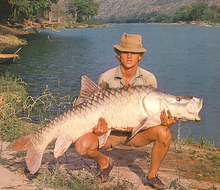Tor remadevii
| Orange-finned mahseer | |
|---|---|

| |
| Scientific classification | |
| Domain: | Eukaryota |
| Kingdom: | Animalia |
| Phylum: | Chordata |
| Class: | Actinopterygii |
| Order: | Cypriniformes |
| Family: | Cyprinidae |
| Genus: | Tor |
| Species: | T. remadevii
|
| Binomial name | |
| Tor remadevii Kurup & Radhakrishnan, 2007
| |
Tor remadevii, the orange-finned mahseer, also known as the hump-backed mahseer, is a Critically Endangered species of freshwater fish endemic to the Western Ghats of India.[2] It is restricted to the Kaveri river basin.
It can be distinguished from other mahseer by the prominent hump originating above the pre-opercle, a distinctive kink in the pre-opercule, a terminal mouth position, and its bright orange caudal fin. It is considered a high-quality game fish, and has been proclaimed by anglers as "the largest and hardest fighting freshwater fish in the world".[3]
Conservation Issues
Among the reasons for the species' extreme threat status is the introduction of non-native mahseers
Despite this endangered status, the general lack of a formal scientific name had previously hampered efforts to protect the species. However, a 2018 study found that the orange-finned mahseer was in fact conspecific with Tor remadevii, a little-known species identified in 2007 based on 19 individuals [7] sampled from the Pambar River in 2004.[8] This has allowed the species as known from historic records across the whole river basin to finally gain a scientific name and an updated Red Listing. These will both be of help for future conservation efforts.
Gallery



References
- . Retrieved 19 November 2021.
- ^ "Tor remadevii". IUCN Red List of Threatened Species. Retrieved 15 January 2019.
- ^ DOI: https://doi.org/10.3354/esr00673
- ^ https://eprints.bournemouth.ac.uk/34337/1/Pinder%20et%20al_JoTT_2020.pdf
- ^ "Tales from Velimeen Land". 20 August 2021.
- ^ "Can its scientific name save India's famed hump-backed mahseer?". Research Matters. 22 June 2018. Retrieved 30 June 2018.
- ^ Kurup, B Madhusoodana; Kurup, B. Madhusoodana; Radhakrishnan, K. V. (23 January 2024). "Tor Remadevii, A New Species of Tor (Gray) from Chinnar Wildlife Sanctuary, Pambar River, Kerala, Southern India". The Journal of the Bombay Natural History Society. 107 (3): 227––230.
- PMID 29924871.

